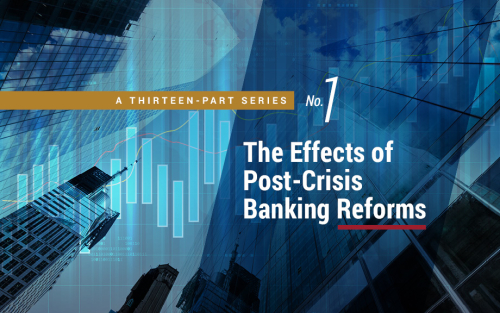Bank‑Intermediated Arbitrage

Since the 2007-09 financial crisis, the prices of closely related assets have shown persistent deviations—so-called basis spreads. Because such disparities create apparent profit opportunities, the question arises of why they are not arbitraged away. In a recent Staff Report, we argue that post-crisis changes to regulation and market structure have increased the costs to banks of participating in spread-narrowing trades, creating limits to a¬rbitrage. In addition, although one might expect hedge funds to act as arbitrageurs, we find evidence that post-crisis regulation affects not only the targeted banks but also spills over to less regulated firms that rely on bank intermediation for their arbitrage strategies.
Regulatory Changes and the Cost of Capital for Banks

In response to the financial crisis nearly a decade ago, a number of regulations were passed to improve the safety and soundness of the financial system. In this post and our related staff report, we provide a new perspective on the effect of these regulations by estimating the cost of capital for banks over the past two decades. We find that, while banks’ cost of capital soared during the financial crisis, after the passage of the Dodd-Frank Act (DFA), banks experienced a greater decrease in their cost of capital than nonbanks and nonbank financial intermediaries (NBFI).
The Effects of Post‑Crisis Banking Reforms

The financial crisis of 2007-08 exposed many limitations of the regulatory architecture of the U.S. financial system. In an attempt to mitigate these limitations, there has been a wave of regulatory reforms in the post-crisis period, especially in the banking sector. These include tighter bank capital and liquidity rules; new resolution procedures for failed banks; the creation of a stand-alone consumer protection agency; greater transparency in money market funds; and a move to central clearing of derivatives, among other measures. As these reforms have been finalized and implemented, a healthy debate has emerged in the policy and academic communities over the degree to which they have achieved their intended goals and the extent of any unintended consequences that might have arisen in the process.
Fear of $10 Billion

Ten billion has become a big number in banking since the Dodd-Frank Act of 2010. When banks’ assets exceed that threshold, they face considerably heightened supervision and regulation, including exams by the Consumer Financial Protection Bureau, caps on interchange fees, and annual stress tests. There are plenty of anecdotes about banks avoiding the $10 billion threshold or waiting to cross with a big merger, but we’ve seen no systematic evidence of this avoidance behavior. We provide some supporting evidence below and then discuss the implications for size-based bank regulation—where compliance costs ratchet up with size—more generally.
A Peek behind the Curtain of Bank Supervision
How Does Supervision Affect Banks?
The Economics of Bank Supervision: So Much to Do, So Little Time

Thomas M. Eisenbach, David O. Lucca, and Robert M. Townsend While bank regulation and supervision are the two main components of banking policy, the difference between them is often overlooked and the details of supervision can appear shrouded in secrecy. In this post, which is based on a recent staff report, we provide a framework […]
Supervising Large, Complex Financial Institutions: Defining Objectives and Measuring Effectiveness

Last month the New York Fed held a conference on supervising large, complex financial institutions. The event featured presentations of empirical and theoretical research by economists here, commentary by academic researchers, and panel discussions with policymakers and senior supervisors. The conference was motivated by the recognition that supervision is distinct from regulation, but that the difference between them is often not well understood. The discussion focused on defining objectives for supervising the large, complex financial companies that figure so prominently in our financial system and ways of measuring how effectively supervision achieves these goals. This post summarizes the key themes from the conference and introduces the more in-depth posts that will follow in this blog series.












 RSS Feed
RSS Feed Follow Liberty Street Economics
Follow Liberty Street Economics